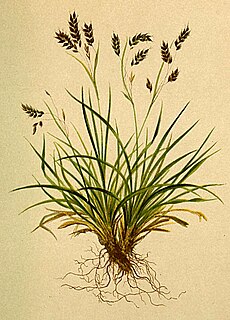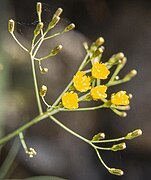
Sonchus is a genus of flowering plants in the dandelion tribe within the sunflower family.

The smooth hawksbeard, Crepis capillaris, is a species in the dandelion tribe within the sunflower family, native to Europe. It has become naturalized in other lands and is regarded as a weed in some places.

Sonchus asper, the prickly sow-thistle, rough milk thistle, spiny sowthistle, sharp-fringed sow thistle, or spiny-leaved sow thistle, is a widespread plant in the dandelion tribe within the daisy family.

Sonchus oleraceus, with many common names including common sowthistle, sow thistle, smooth sow thistle, annual sow thistle, hare's colwort, hare's thistle, milky tassel, milk thistle, soft thistle, or swinies, is a plant in the dandelion tribe within the daisy family.

Sonchus arvensis, the field milk thistle, field sowthistle, perennial sow-thistle, corn sow thistle, dindle, gutweed, swine thistle, or tree sow thistle, is a species of flowering plant in the daisy family Asteraceae. S. arvensis often occurs in annual crop fields and may cause substantial yield losses.

Agrostis capillaris is a rhizomatous and stoloniferous perennial in the grass family (Poaceae). It is native to Eurasia and has been widely introduced in many parts of the world. Colonial bent grows in moist grasslands and open meadows, and can also be found in agricultural areas, roadsides, and invading disturbed areas.
Muellerius capillaris, also known as the hair or goat lungworm, is one of the most economically important nematodes of small ruminants. Although normally non-pathogenic in sheep, the parasite causes a disease condition called muelleriosis in goats. Sheep and goats commonly become infected after accidentally ingesting M. capillaris infected snails or slugs, and the parasite produces eggs in the lungs of its host, causing life-threatening bronchopneumonia in serious cases.

Tillandsia capillaris is a species in the genus Tillandsia. This species is native to southern and western South America.

Sonchus tenerrimus is a species of flowering plant in the aster family known by the common name slender sowthistle. It is native to the Mediterranean region of southern Europe, northern Africa, and the Middle East. It has been found as well in several other locations around the world, historically in association with ship ballast in coastal regions. It has become naturalized in a few places, such as California in the United States and Baja California in Mexico.

Crombrugghia distans is a moth of the family Pterophoridae. It is found in almost all of Europe, as well as Asia Minor, North Africa and the Canary Islands. It is also known from India, Iran and Afghanistan.

Sonchus palustris, commonly known as marsh sowthistle, is a plant native to temperate regions of the Europe, Russia, Central Asia, and Xinjiang in western China. It has also become naturalized in a few locations in the Canadian Province of Ontario.

Phycitodes albatella is a species of snout moth. It is found in most of Europe, Uzbekistan and North America.

Muhlenbergia capillaris, commonly known as the hairawn muhly, is a perennial hedge-like plant that grows to be about 30–90 cm (0.98–2.95 ft) tall and 60–90 cm (2.0–3.0 ft) wide. The plant itself includes a double layer; green leaf-like structures surround the understory, with purple-pink flowers out-growing them from the bottom up. The plant is a warm-season grass, meaning that leaves begin growth in the summer. During the summer, the leaves will stay green, but they morph during the fall to produce a more copper color. The seasonal changes also include the flowers, as they grow out during the fall and stay healthy till the end of autumn. The muhly grows along the border of roads and on plain prairies. The grass clumps into herds, causing bush-like establishments in the area that the hairawn muhly inhabits. The flowers are very feathery and add a cloudlike appearance to the top of the grass. It is native to eastern North America and can be used for a multitude of purposes including ornamental gardening and farming. It was voted 2012 plant of the year by the Garden Club of America.

Sonchus brachyotus is an Asian species of plants in the dandelion tribe within the daisy family. It is widespread across much of northern Asia, found in Japan, Korea, China, Russia, Mongolia, Thailand, Kazakhstan, Caucasus, Kyrgyzstan, etc.
Sonchus wightianus is an Asian species of plants in the dandelion tribe within the daisy family. It is widespread across much of Asia, found in China, the Indian Subcontinent, and Southeast Asia as far south as Indonesia.

Wahlenbergia capillaris, commonly known as tufted bluebell, is a plant in the family Campanulaceae and is native to Australia and New Guinea. It is an erect perennial herb with a few to many stems and grows to a height of 50 cm (20 in). The leaves are mostly linear with a few scattered teeth on the sides and the flowers are blue, bell-shaped with five lobes and arranged in cymes. This bluebell is widespread and common, occurring in all Australian mainland states and territories.

Sonchus congestus is a species of flowering plant in the family Asteraceae. It is endemic to the Canary Islands.

Carex capillaris, the hair-like sedge, is a species of sedge found in North America and northern Eurasia.


















